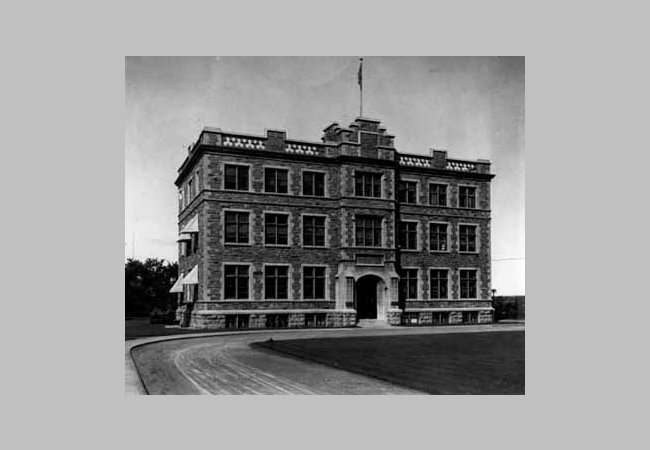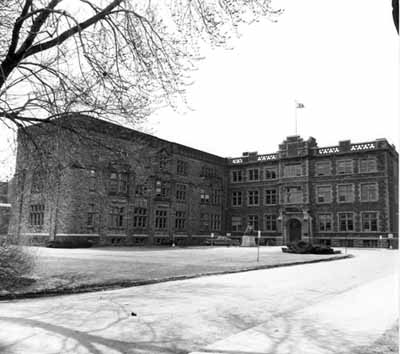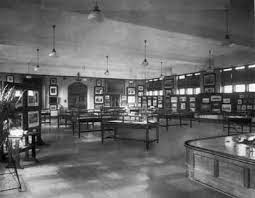
Never Have So Many Known So Little About So Much.
Please sojourn with me and let me introduce to you the disclosure of facts by Russell Roger Smith. Born February 16, 1884 at Fort Qu’appelle in the District of Assiniboia in the Northwest Territories. Twenty-one years later, the provinces of Saskatchewan and Alberta were carved from what was then these Territories.
His father, Richard James Smith, who was employed by the C.P.R. in building the wooden bridges for the railroad, and three others of his crew, induced Surveyor Dewdney, in charge of surveys for the railway, to survey homesteads for them in the Qu’Appelle valley. These were the first homesteads surveyed in what is now the province of Saskatchewan.
Because his parents fed the natives when they were starving, his father was made a blood brother of the Crees and later R. Roger Smith was made a chief of the tribe (Chief Wapanatak, “Morning Star” in Cree). R. Roger Smith became a mechanical engineer and as a hobby a student of international and constitutional law. And ninety-six years ago he drafted the Resolution which Rt. Hon. William Lyon Mackenzie King presented to the Imperial Conference of 1926, which is recognized as being the basis for the enactment by the United Kingdom of the Statute of Westminster, Dec.11, 1931.
The Statute of Westminster created sovereign nations of the 10 provinces of the day. These provinces/nations hold the alloidal title on behalf of the people of each Province. R. Roger Smith wrote three sections within this Statute of Westminster pertaining to Canada.
Early in 1935, after lengthy talks with Chief Justice Morrison of the Supreme Court of British Columbia, Smith asked “Has British Columbia a copy of the British North America Act ?”
“No” he informed Smith “Of course the original provinces namely Nova Scotia, New Brunswick, Quebec and Ontario would have copies of the original, but may I suggest that you could see the original or a duplicate of the original in Ottawa.”
Smith thanked the Chief Justice and mentions that he planned to be in Ottawa in the fall and would visit the Archives then…
Arriving in Ottawa the first week in November, Smith visited the Archives and was directed to the Reference Library.
Smith spoke with Colonel Hamilton who was in charge, for a certified or duplicate copy of the British North America Act. As the Act was still in force, the Archives would not have the document until the Government was finished with it.
“You had better contact the Privy Council.” he said, “Do you know Mr. Lemaire, the Chief Clerk?”
“No” Smith replied as he was visiting from Vancouver.
There, Colonel Hamilton did provide Smith with the original papers written by the delegates who presented the Quebec Resolutions when they went to London, England in 1866. Smith spent two weeks in the Archives. As he finished with each document, it was returned and another placed before him.

The name of each delegate was across the top of each copy which was a revision of the Quebec Resolutions, but none were signed at the bottom. Further, no confederation agreement was drafted or signed by them as observed and recorded by Smith in his book Ho Canada, written in 1965.
Colonel Hamilton arranged an appointment for Smith to meet with Mr. Lemarie of the Privy Council and upon this meeting, Mr. Lemarie said “As the Privy Council does not have a copy of the Original; I think the best place would be the Office of the Governor-General.”
Mr. Lemarie’s secretary introduced Smith to Mr. Periera, the Governor-General’s secretary.
Mr. Periera wrote a note for Smith and said, “Just give this note to Mr. Hardy, the Parliamentary Librarian.”
Upon meeting Mr. Hardy, he laughed and said, “This is too important a document for us to have in the library. I think that your best plan would be to see Mr. Coleman, Secretary of State. He has an office in the West Block.”
Mr. Coleman was in and to answer Smith’s question he said, “We have no copy that I know of.”
Thanking him, Smith concluded that, “If there was a Confederation in Canada that each province which was a party to the agreement should possess a certified copy.” And added that “He had been informed that he would find a copy in Ottawa.”
“You should see Dr. Beauchesne, Clerk of the House of Commons who is an authority on the British North America Act, and if he does not have a certified copy, he will tell you where to find it,” Advised Mr. Coleman.
Meeting with Dr. Beauchesne, venerable Chief Clerk of the House of Parliament in Ottawa and author of Beauchesne’s Parliamentary Rules and Forms, after being introduced he asked and then stated, “What did they send you to me for? They know that I keep no valuable documents here, and this most valuable document would be kept closely guarded somewhere in a vault. There is such a vault under the Senate Chamber but you would have to see Dr.Blount, Clerk of the Senate.”

Smith made his way through the lofty corridors of the House of Parliament leading to Dr. Blount’s office. There Smith shared his adventure with Dr. Blount, Dr. Blount stated, “You know, you have me very much interested. Do you mean to say that you have been to all these places and you have not found any certified copy of the Act? Well! We have a vault under the Senate, but I do not know of any copy there. If you would care to look, you are welcome.”
Dr. Blount, the assistant and Smith descended to a high ceiling vault which had shelves about ten feet up from the floor.
Certified copies, which must be stamped with the seal of the Senate, as well as certified copies of orders in council, are in hardwood cases on the shelves, each marked with the year’s date.
The assistant handed down two cases, 1867 and 1868 which Dr. Blount turned over to Smith for inspection.
Not finding a copy of the British North America Act, Smith asked if they had been destroyed in the fire.
“No” Dr. Blount assured Smith. “The Parliament buildings were destroyed but we saved the Library and this vault…”
“Was this British North America Act ever presented to the Senate?” Smith asked.
“We can check the records in my office.” Dr. Blount replied.
After consulting his book of records, he assured Smith that it had not been presented to the Senate.
“Was it ever presented to parliament?” was Smith’s next question.
“You will have to ask Dr. Beauchesne.” he said.
Smith retraced his steps back to the office of Dr.Beauchesne and related to him his failure to find any certified copy and that Dr. Blount could find no record of it in his office. “Would it have been placed before Parliament?”
Dr. Beauchesne called for the records of the House of Commons and after looking over the records, he told Smith, that it had never been placed before Parliament.
“Well Doctor, if a copy of this Act had ever been brought to Canada, it would be here, would it not?” Smith asked.
“Yes of course,” the Doctor replied.
“Then, Doctor, I think we can say that no copy of this Act was ever brought to Canada, is that correct?”
“I am very much afraid that you are correct,” was his answer.
So to recap, the British North America Act was never presented to Parliament and the House of Commons.
So… here are 11 very important questions that you need to ask yourself:
- Where are the Articles of Confederation, if Canada had confederated in 1867 and is a sovereign nation?
- Why was Canada known as the “Dominion of Canada” a British colony until 1938, if Canada had confederated in 1867 and is a sovereign nation?
- Why in 1867 was the BNA act created to be Letters Patent for a Governor General to the Dominion of Canada if Canada had confederated and is a sovereign nation?
- Why in 1893, would the British Parliament deem it necessary to repeal certain sections of the BNA act, with the “Statute Law Revisions act” if Canada confederated in 1867 and is a sovereign nation?
- Why in 1931 would the British parliament create the “Statute of Westminster” to nullify the Dominion of Canada, if Canada confederated in 1867 and is a sovereign nation?
- Why in 1946 did a foreign Monarch, King George VI appoint a representative for the UK, a Governor General and then command the Parliament of Canada to create Letters Patent and command the PM at that time to sign on his behalf those Letters Patent in 1947 for his Governor General, if Canada confederated in 1867 and is a Sovereign Nation?
- Why did PM Trudeau in 1982 have the government create the “Canada Bill” and then take that Bill to a foreign Monarch and have her parliament pass that Bill as the “Canada Act, 1982” if Canada confederated 115 years earlier and is a sovereign nation?
- Why do Prime Ministers and other officials when sworn into office here in Canada, swear their allegiance to a foreign monarch, Queen Elizabeth, and not to the people of Canada if Canada confederated in 1867 and is a sovereign nation?
- If Canada is a sovereign nation, why does the Government of Canada in their Interpretations Act define Canada as the internal waters and territorial seas if Canada confederated in 1867?
- Why was it necessary in 1990 to sue a member of the federal parliament, J. Littlechild MP, to force him to do his duty to his constituents and have the courts rule against his constituents, if Canada had confederated in 1867 and is a sovereign Nation?
- Why in the “Constitution Act, 1982” of Canada is there no clause that allows for land for the Government of Canada to become a sovereign nation if Canada Confederated in 1867 and is a sovereign nation?
If the people in the 12 sovereign nations (Provinces and Territories) could awaken to what the Government of Canada Inc. really is (master that owns them upon their consent) and take the blinders off that were put there by those who call themselves the government, we could all have a bright future. The Government of Canada Inc. has painted itself as some sort of religious fairy tale set out to save everyone and keep them safe. Once people realize the truth and claim ownership over their land they can truly be free. Let us help you see the truth, The Myth is Canada.
“You never change things by fighting the existing reality. To change something, build a new model that makes the existing model obsolete.” ~ R. Buckminster Fuller
“One of the saddest lessons of history is this: If we have been bamboozled long enough, we tend to reject any evidence of the bamboozle. We’re no longer interested in finding out the truth. The bamboozle has captured us. It is simply too painful to acknowledge, even to ourselves that we’ve been taken. Once you have given a charlatan power over you, you almost never get it back.” ~ Carl Sagan
Originally written by A Man named Duane.
